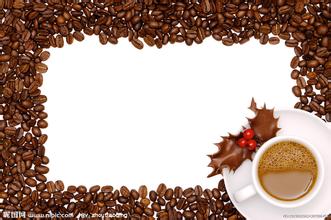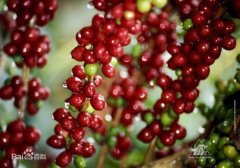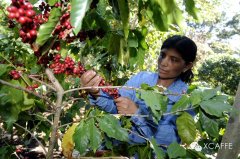Introduction to the products, types and quality of coffee all over the world
⑴ Moga
Moga is actually the place of export of Arabica coffee, not the place of origin, and now the trade export port of Arabica coffee has been transferred to the south of Aden. The coffee sold under the name of Moga is made from coffee beans grown in the highlands of Yemen. It is said that the original species was transplanted from Arabia, but the yield is not high. Some of the coffee sold under the brand name of Moga on the market is not Arabian coffee, but Arabian coffee grown in other places.
⑵ Indonesia
Java Islands, Sumatra. Coffee from Sibes Island is collectively referred to as Indonesian coffee. During the Dutch colonial era, local farmers were forced to grow coffee, which was collected by the authorities, and Arabian coffee trees were introduced at the beginning, but because of their weak resistance to disease, they planted Robusta coffee trees instead. This kind of coffee has a unique flavor and is said to have a rich flavor. It tastes better if it is mixed with mocha coffee.
⑶ Brazil
Brazilian coffee accounts for 3/4 of the world's total coffee production. The brand names of Brazilian coffee are mostly taken from the place names of the port of export, such as Santos coffee, Leo coffee, Victorian coffee, Brazilian coffee and so on.
The taste of Santos coffee beans is completely comparable to that of mocha coffee.
Leo coffee beans have a special flavor, and strong irritation, not to the taste of ordinary people, so not as good as Santos coffee.
Victorian coffee beans have a kind of earthy taste, but after improvement, the earthy taste has been reduced. This kind of coffee beans tastes softer after fried
The coffee bean system in Brazil is excellent and is welcomed by the public.
In addition to the above coffee beans, coffee beans in Ecuador, Bolivia, Peru, Colombia and other real estate are also included in the mild coffee category. And Hawaiian Cona beans enter the market as mixed coffee beans.
2, world-famous coffee
In the market, we can often see raw coffee beans with different names. Basically, each kind of coffee has its own special flavor, and the origin of its name is mostly based on origin and variety. In fact, nearly 90% of the coffee consumed in the world today is good acid coffee, and the remaining 10% is non-acidic.
There are several kinds of common coffee beans
⑴ Blue Mountain, a sacred coffee product with a soft fragrance, is produced in the high mountains of Jamaica in the West Indies. Due to its limited production and high price, most of the Blue Mountain coffee drunk in the market is an imitation.
⑵ Jamaica, tastes clear and elegant, vanillic acid is second to Blue Mountain, but unique.
⑶ Columbia, mellow and thick, sour and smooth, has a peculiar sweet potato skin flavor. It is a good taste in coffee and is often used to add flavor to other coffees.
⑷ mocha, with its unique aroma and sweet and sour flavor, is an ideal variety for blending mixed coffee.
⑸ Mantenin, strong fragrance, bitter, mellow, single drink, for supreme enjoyment.
⑹ Guatemala, sweet and fragrant lips, neutral beans, taste very similar to Colombian coffee.
⑺ Santos, Brazil, light fragrance slightly sweet, roasting heat must be properly controlled in order to give full play to its characteristics.
In addition to the above several kinds of coffee, other coffee beans, such as Clemangaro, Java, Ivory Coast, Nicaragua, Costa Rica, Ecuador and so on, have different soft and sweet acids, and all kinds of coffee beans can be drunk individually or mixed. Usually mixed with more than three kinds of coffee, called comprehensive coffee, because they are carefully mixed, there is no lack of delicious taste.
After more than ten centuries of development and evolution, coffee has its own living space, and each place produces different tastes, either sweet or sour, fragrant or mellow, bitter or strong. In addition to the differences in nature, the skill of coffee making can also be said to be the biggest factor.

Important Notice :
前街咖啡 FrontStreet Coffee has moved to new addredd:
FrontStreet Coffee Address: 315,Donghua East Road,GuangZhou
Tel:020 38364473
- Prev

Mexico's best coffee producer is Chiapas Black Coffee in the south of the country.
The term "fine coffee" was first put forward by Ms. Knudsen of the United States in Coffee and Tea magazine. At that time, Ms. Knudsen, as a coffee buyer at B.C. Ireland in San Francisco, was very dissatisfied with the neglect of the quality of raw coffee in the industry, and even some big roasters mixed a large amount of Robesda beans in the comprehensive beans, so she put forward the concept of boutique coffee.
- Next

The excellent Nicaraguan coffee is among the top blends in the world.
The term "fine coffee" was first put forward by Ms. Knudsen of the United States in Coffee and Tea magazine. At that time, Ms. Knudsen, as a coffee buyer at B.C. Ireland in San Francisco, was very dissatisfied with the neglect of the quality of raw coffee in the industry, and even some big roasters mixed a large amount of Robesda beans in the comprehensive beans, so she put forward the concept of boutique coffee.
Related
- Does Rose Summer choose Blue, Green or Red? Detailed explanation of Rose Summer Coffee plots and Classification in Panamanian Jade Manor
- What is the difference between the origin, producing area, processing plant, cooperative and manor of coffee beans?
- How fine does the espresso powder fit? how to grind the espresso?
- Sca coffee roasting degree color card coffee roasting degree 8 roasting color values what do you mean?
- The practice of lattes: how to make lattes at home
- Introduction to Indonesian Fine Coffee beans-- Java Coffee producing area of Indonesian Arabica Coffee
- How much will the flavor of light and medium roasted rose summer be expressed? What baking level is rose summer suitable for?
- Introduction to the characteristics of washing, sun-drying or wet-planing coffee commonly used in Mantenin, Indonesia
- Price characteristics of Arabica Coffee Bean Starbucks introduction to Manning Coffee Bean Taste producing area Variety Manor
- What is the authentic Yega flavor? What are the flavor characteristics of the really excellent Yejasuffi coffee beans?

